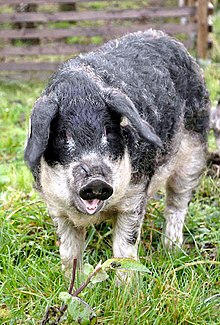Mangalitsa
 |
|
| Other names |
|
|---|---|
| Country of origin | Kingdom of Hungary |
| Traits | |
| Weight |
|
| Hair |
|
|
|
The Mangalica (also Mangalitsa or Mangalitza) is a Hungarian breed of domestic pig. It was developed in the mid-19th century by crossbreeding Hungarian breeds from Szalonta and Bakony with European wild boar and the Serbian Šumadija breed. The Mangalica pig grows a thick, woolly coat similar to that of a sheep. The only other pig breed noted for having a long coat is the extinct Lincolnshire Curly-coated pig of England.
The blonde Mangalica was developed from older, hardy types of Hungarian pig (Bakonyi and Szalontai) crossed with the European wild boar and a Serbian breed (and later others like Alföldi) in Austro-Hungary (1833). The development took place in Austro-Hungary (present-day Arad County in Romania) in the early 19th century. The new, quick-growing, "fat-type" hog did not require any special care, so became very popular in Hungary. In 1927, the National Society of Fat-Type Hog Breeders (Mangalicatenyésztők Országos Egyesülete) was established, with the objective of improving the breed. Mangalica was the most prominent swine breed in the region until 1950 (30,000 of them were in Hungary in 1943). Since then, the popularity, as well as the population, of Mangalica has been decreasing, with the rising availability of food from farther away and refrigeration. On 1991 there were less than 200 animals in Hungary. Monte Nevado, a Spanish company began the breeding and recovery of Mangalica and for this they were awarded with the Middle Cross of Hungary in 2016. http://www.qcom.es/v_portal/informacion/informacionver.asp?cod=29497&te=2849&idage=32707&vap=0 Nowadays, the keeping of Mangalicas has become a popular hobby. Slightly over 7,000 Mangalica sows in Hungary are producing around 60,000 piglets a year.
Apart from Hungary, the Mangalica is present in Austria, the Czech Republic, Germany, Romania, Serbia, Slovakia and Switzerland. In March 2006, seventeen of the pigs were exported from Austria to the United Kindgom, where they are registered with the British Pig Association. In 2007 some were exported to the United States.
...
Wikipedia
